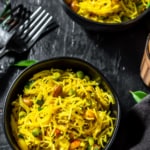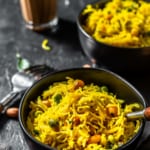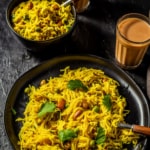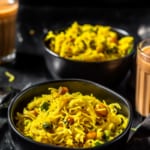Semiya Upma (Lemon Vermicelli)
Note: This post contains affiliate links. As an Amazon Associate I earn from qualifying purchases.
This delicious and tangy Semiya Upma (Lemon Vermicelli) is just what you need to start your day. It is filling and comes together in 15 minutes from start to finish.
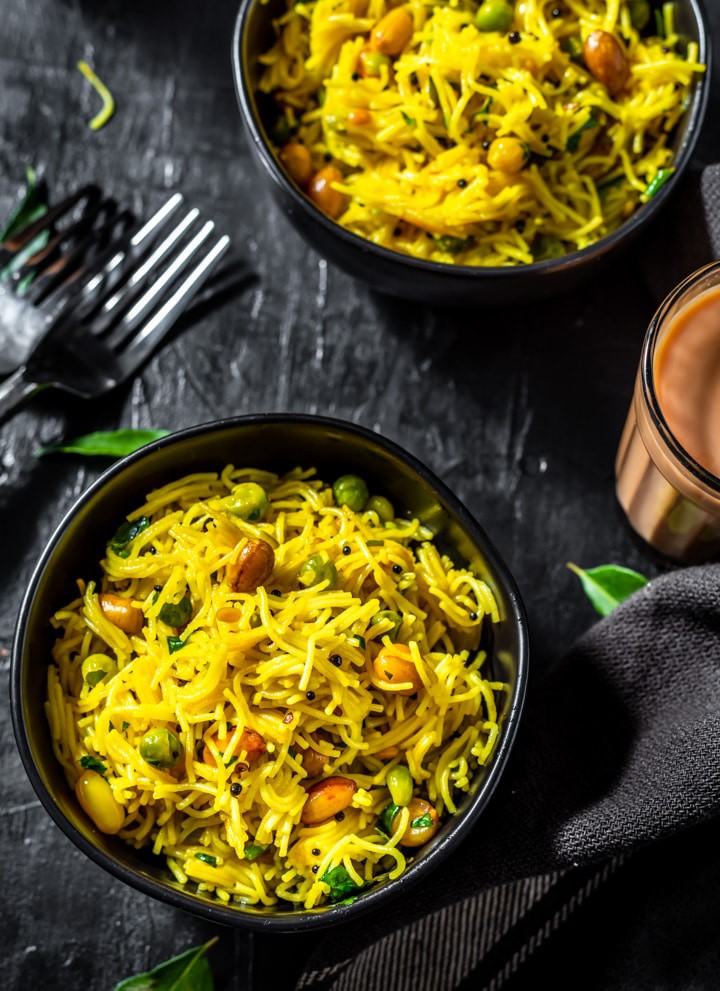
For those who are on the lookout for delicious Indian breakfast recipes that are super easy to make, then lemon vermicelli (semiya upma) fits the bill perfectly. It is a versatile dish that can be served as breakfast and even brunch. Throw in some veggies to make it filling. It is best served hot, accompanied by a hot cup of tea or coffee.
What is semiya / vermicelli made of?
Semiya or Vermicelli are long thin noodles not very different from spaghetti. These noodles are added to a tempering of oil and spices and then cooked in boiling water till it has softened. The preparation is very similar to upma – a south Indian breakfast dish, that’s why the name semiya upma. This dish gets its lovely yellow color from turmeric powder, and the tang is provided by freshly squeezed lemon juice.
Semiya or Sevai (as it is called in South India), when made from scratch at home, is rice flour-based. The store-bought versions are wheat-based and use semolina (or sooji) or all-purpose flour (maida).
What kind of Vermicelli is best for this dish?
I recommend Bambino brand vermicelli since it is made from wheat semolina. That’s why I prefer it over the ones made from all-purpose flour (maida).
You can buy either the roasted or the unroasted one to make this dish. If you can’t find this particular brand in your local Indian store, substitute it with rice vermicelli from a South Asian store.
Note –
- If you are using rice noodles, follow the instructions on the packet on how to cook it. Rice noodles are often soaked in hot water and NOT cooked in it, so be mindful of that.
- I have used roasted vermicelli for this recipe. If you can’t find roasted vermicelli where you live, heat a teaspoon of ghee or oil in a pan on medium heat and roast the vermicelli till they change color (almost light brown).
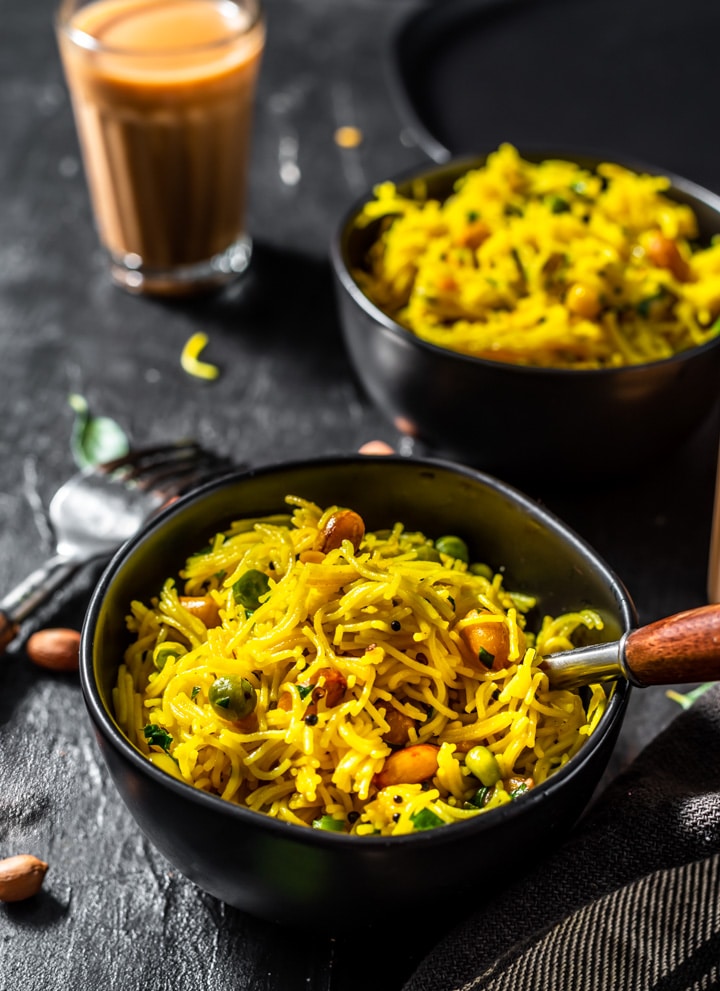
How to make semiya upma (lemon sevai)
This semiya upma recipe is easy to make – the tricky part is to know how much water to use – too much and your vermicelli (sev) will overcook and become one lumpy mess; too little and you end up with an undercooked dish. I am sure you want neither, so make sure you closely follow the instructions found in your vermicelli packet or if none’s provided, use a 1:2 semiya upma water ratio i.e. 2 cups of water for every cup of vermicelli.
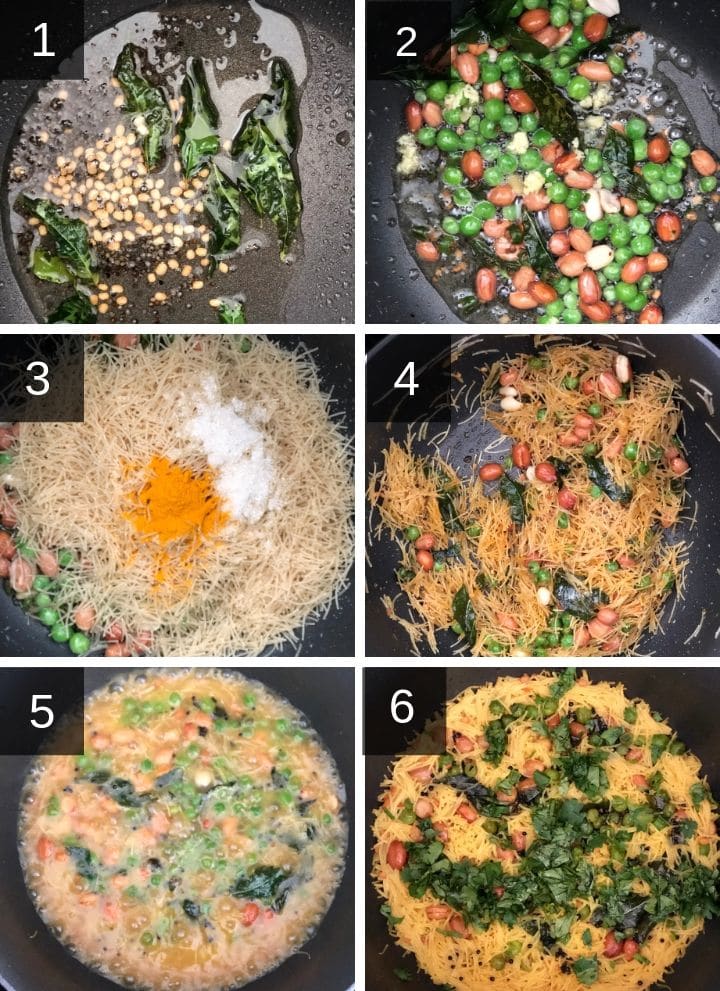
- Set 2 cups of water to boil in a saucepan.
- Heat a tablespoon of oil in a non-stick kadhai/wok on medium heat, and when the oil gets hot, add mustard seeds.
- When the mustard seeds start to sputter, add urad dal, curry leaves, skinned peanuts, green chilies, and cashews (if using). Let it fry for about a minute till the peanuts get a nice crunch to it.
- Add veggies such as peas and finely chopped carrot, if using. Mix well.
- Add roasted vermicelli (sev), turmeric powder, salt, and sugar and sauté it for a minute.
- Reduce the heat to medium-low and add the water that was set to boil.
- Cover the wok/kadhai with a lid till the water is almost absorbed (8-10 minutes). (Do a quick check around 4 minutes to make sure the vermicelli is not sticking to the side of the pans. If it does, give it a quick stir).
- Add the lemon juice and blend it in the vermicelli evenly. Garnish it with chopped cilantro and serve lemon semiya immediately.
Variations
- Lemon sevai tastes good even after a couple of hours, and that makes it a popular school lunch option. Throw in some veggies, such as carrots, peas, etc., right before you add boiled water, and you are all set.
- You can substitute skinned peanuts with roasted peanuts, but I prefer skinned ones because it offers a myriad of health benefits and tastes better too!
- For a nut-free version – skip the peanuts and cashews, and use olive oil or sesame oil instead.
- Garnish with a tablespoon of freshly grated coconut to amp up the flavor.
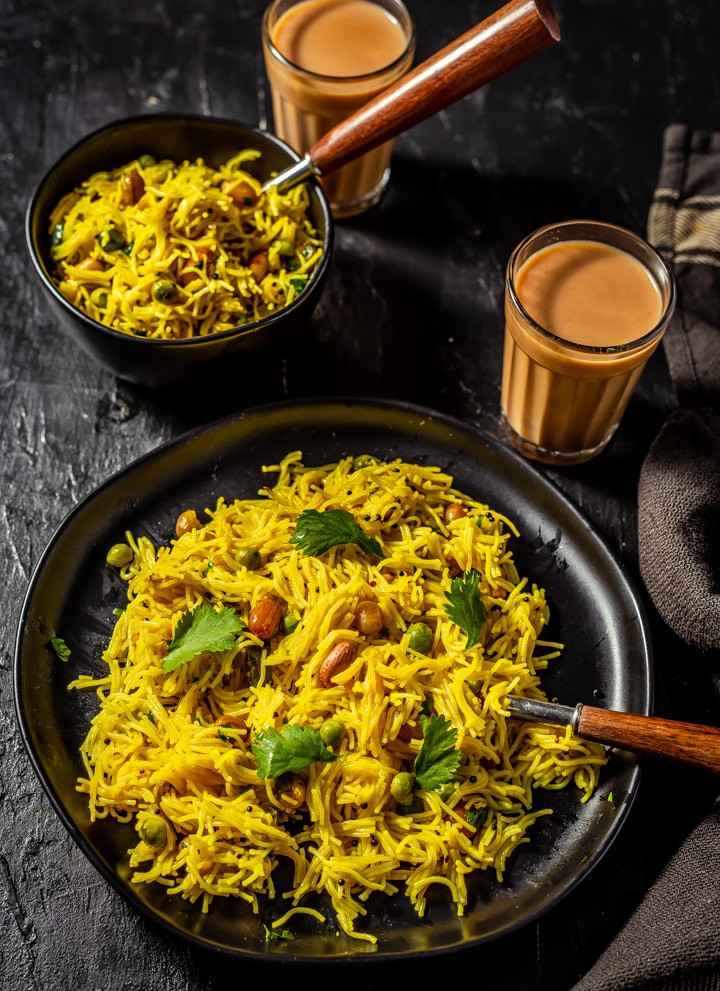
How many calories are in semiya upma?
The calories in semiya upma can vary depending on what kind of vermicelli you are using for your recipe. One serving of my lemon sevai recipe is approximately 360 calories.
Hope you liked this lemon sevai recipe, and if you are looking for easy and delicious breakfast recipes, here are my top picks –
- Suji upma – a semolina-based breakfast dish that takes less than 30 minutes.
- Idli – You’ll love this post if you have been struggling to get soft and spongy idlis. Learn all my tips and tricks to get perfect fermented batter even in winter!
- Buttermilk dosa – Buttermilk dosa – Delicious and soft, this dosa is perfect for breakfast, snacks, and even lunch. Learn how to make it in a few easy steps.
- Kapparutti – Kappa rutti or Kappa rotti – This soft in the center and crispy on the sides 4-ingredient dosa or pancake from Mangalore is a culinary delight. Try it out today – no fermentation required!
- Non-Sticky Sabudana Khichdi – This step-by-step recipe will show you how to make sabudana khichdi that looks as great as it tastes. No more clumpy or sticky mess!
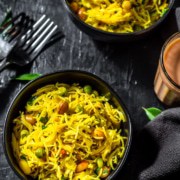
Semiya Upma (Lemon Vermicelli) Recipe
Ingredients
- 2 cups water
- 1 tablespoon oil peanut or sesame
- ½ teaspoon mustard seeds
- 1 sprig of curry leaves or kadipatta
- ¼ teaspoon urad dal
- 2 tablespoons skinned peanuts
- 1 tablespoon cashew pieces optional
- 2 Indian or Thai green chilies (Bird's eye) finely chopped
- 1 cup roasted sev / vermicelli I use the Bambino brand
- ¼ cup green peas optional
- ½ teaspoon turmeric powder
- 1 teaspoon sugar
- salt to taste
- 1 tablespoon lime juice
- 2 tablespoons finely chopped cilantro
Instructions
- Set water to boil. Once finished, turn off the heat.
- Heat a tablespoon of oil in a non-stick kadhai/wok on medium heat. When the oil gets hot, add mustard seeds.
- Once the mustard seeds start to sputter, add curry leaves, urad dal, skinned peanuts, green chilies, and cashews (if using).
- Let fry for about a minute till the peanuts become crunchy.
- Add veggies, such as peas and carrots, if using. Mix well.
- Add roasted vermicelli (sev), turmeric powder, salt, sugar and sauté for a minute.
- Reduce the heat to medium-low and add the boiling water.
- Cover the wok/kadhai with a lid till the water is almost absorbed (8-10 minutes). (Do a quick check around 4 minutes to make sure the vermicelli is not sticking to the side of the pans. If it is, give it a quick stir).
- Add the lemon juice and blend into the vermicelli evenly. Garnish with chopped cilantro and serve immediately.
Notes
- You can buy either the roasted or the unroasted one to make this dish. If you can’t find this particular brand in your local Indian store substitute it with rice vermicelli from a South Asian store.
-
I used roasted vermicelli for this recipe. If you can’t find roasted vermicelli where you live, heat teaspoon of ghee or oil in a pan on medium heat and roast the vermicelli till they change color (almost light brown).
- If you are using rice noodles, follow the instructions on the packet on how to cook it. Rice noodles are often soaked in hot water and NOT cooked in it, so be mindful of that.
-
This recipe can easily be doubled. Make sure to follow the 2:1 ratio i.e. 2 cups of water for every cup of vermicelli.
-
Lemon Vermicelli is a great lunch option as well. Throw in some veggies such as carrots, peas, etc. right before you add boiled water and you are all set.
-
You can substitute skinned peanuts with roasted peanuts but I prefer skinned peanuts because it offers a myriad of health benefits.
-
For a nut-free version – skip the peanuts and cashews, and use olive oil or sesame oil instead.
-
Garnish with a tablespoon of freshly grated coconut to amp up the flavor.
Disclaimer: Approximate nutritional information is provided as a courtesy and can vary depending on the exact ingredients/brands used. If you have health issues, please work with a registered dietician or nutritionist.
Nutrition
This recipe was originally published in June 2014 and has been completely updated on August 8th, 2019.

